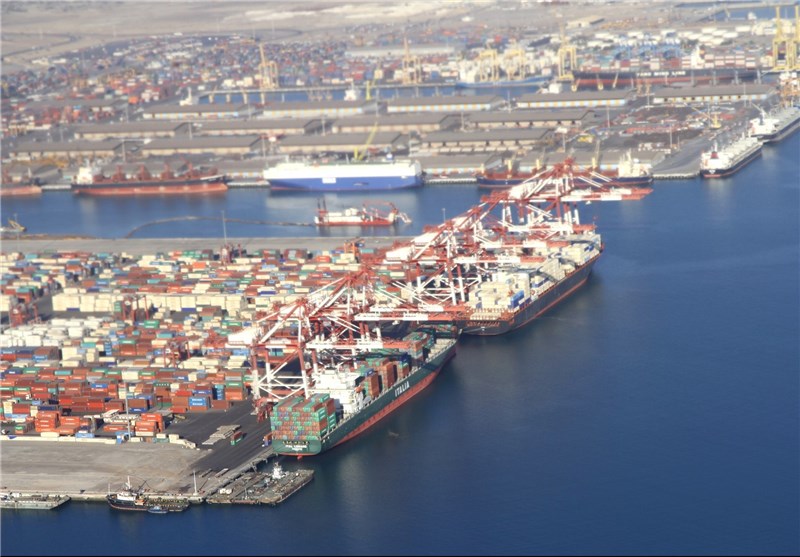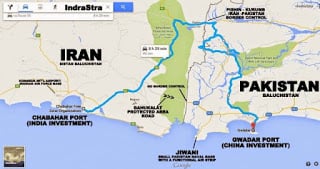Why Did the US Issue a Sanctions Waiver for Iran’s Port of Chabahar?

Many observers are wondering why the US issued a sanctions waiver for the Indian-built port of Chabahar in southeastern Iran and the railroad project that’s supposed to one day extend from it to Afghanistan, but the reason is that America sees this curious “Lead From Behind” arrangement as one of its last chances to retain its long-term influence in the landlocked country.
For as tough as the US promised that its reimposition of sanctions on Iran would be, it unsurprisingly went soft when it came to the issue of the Indian-built port of Chabahar in the southeastern part of the Islamic Republic. The State Department confirmed earlier this week that the US granted a sanctions waiver for this project, which simultaneously drew attention not only to the project’s significance, but also the special nature of the American-Indian Strategic Partnership if Washington thought it important enough to preserve at the expense of undermining its sanctions regime against Iran. The reason for this is that the US understands the long-term strategic ramifications of redirecting Afghanistan’s international trade away from Pakistan (and increasingly China) and towards the rest of the world market via the access that it obtains through Chabahar, which is why the railroad that’s supposed to branch off from this port to the landlocked country is also excluded from the sanctions regime.

Between A Rock And A Hard Place
The US isn’t just losing influence in Afghanistan on the military front after the Taliban’s recent spree of gains across the country, but also on the economic one as well after China’s recent inroads there, which America worries could soon have political consequences if Beijing succeeds in establishing new patronage networks with the internationally recognized Kabul elite. This could in turn make it less likely that the US can keep Kabul and the Taliban from striking a deal, especially one at its expense, which is why there’s such an interest in ensuring that America can still retain its control over Afghanistan’s permanent military, intelligence, and diplomatic bureaucracies (“deep state”). Suitcases full of cash aren’t sustainable, whereas the clinching of privileged business deals with China are, hence why the US had to urgently streamline a solution and realized that it was forced to rely on its newfound Indian ally.
No reasonable comparison can be made between China’s ability to exert influence in Afghanistan and India’s, but the two BRICS “frenemies” nevertheless did agree to cooperate in jointly training its diplomats. There’s also the possibility that they’ll pool their infrastructure resources together in turning the country into a shining example of the “China-India-Plus-One” framework that they unveiled before this summer’s BRICS Summit, thereby putting an end to the competition between the New Silk Road and the “Asia-Africa Growth Corridor”. On the surface, all of this should be appalling to America because of how much it risks undercutting its strategic ambitions in Afghanistan, but Washington is clearly wagering that mutual suspicions will persist between China and India which will in turn make the railroad a feasible opportunity for indirectly exerting influence through its South Asian “Lead From Behind” partner.
Keeping India In Line
Iran will obviously receive some residual knock-on benefits from being the transit country facilitating Indian-Afghan trade (which, to remember, is intended to function as a more sustainable means of ‘buying off’ Kabul’s “deep state” than suitcases full of cash in the face of China’s New Silk Road competition), but the US is willing to turn a blind eye to that because of how comparatively insignificant those profits will be. After all, the US could always sanction individual Indian or Afghan companies that trade with Iran across this route instead of keeping their economic activities on a strictly bilateral basis (apart from paying transit dues and other unavoidable expenses that go into the country’s coffers), so the plan is at least conceptually viable and doesn’t necessarily subvert the spirit of Trump’s sanctions policy against the Islamic Republic.
It needs to be emphasized that the US is engaging in long-term strategic planning that won’t yield immediate dividends, but that it’s undertaking this approach because of the high level of trust that it’s established with India since the election of PM Modi in 2014. The US now regards India as a strategic partner, one which is indispensable to “containing” China, even though India itself is playing a “double game” by working closer with China over the past few months through a cunning strategy that it regards as “balancing” (officially described as “multialignment” in its official parlance). There’s always the chance that India could disappoint the US, but that’s unlikely since it needs access to the US marketplace to continue its growth and is deathly afraid (whether rightly or wrongly) of having its domestic industries swamped by Chinese imports if it pivots towards the New Silk Road.
A Reason To Rethink The Hybrid War On CPEC
Pakistan and Iran are on the same page regarding the role that third-party actors have in provoking occasional border problems between them through these means, so considering the increasingly strategic importance that both countries attach to their relations with one another, it follows that Tehran’s interests would be best served by leveraging its influence over the Chabahar Corridor to ensure security in the transnational Baloch space. This is the only scenario in which Pakistan could partially benefit from the Chabahar Corridor, so it’s incumbent on those in Islamabad to do everything that they can to encourage their Tehran counterparts to take every step in that direction. The US and India have obvious reasons for wanting to continue their Hybrid War on CPEC, but the argument can be made that their support of Baloch terrorism to this end runs an unacceptably high risk of blowback that could scuttle their joint plans for Afghanistan and the rest of Central Asia.
Concluding Thoughts
The prima facie impression is that the US must have had some reason or another for waiving its sanctions against Chabahar, but cohesive explanations for why this is have been far and few between. It sounds absurd that the US’ interests in Afghanistan are furthered by Iran of all countries and especially at this specific point in time, but that’s the reality as it presently exists. To be clear, Iran isn’t intentionally assisting the US with anything, but its hosting of the Indian-built Chabahar Corridor to Afghanistan could be instrumentalized by Washington through its strategic partnership with New Delhi to advance the US’ grand strategic interests. On the other hand, however, Iran isn’t a completely passive bystander to this process either, and could at the very least work directly with its Indian partner to ensure that neither it nor the US continue their destabilization of Balochistan through the Hybrid War on CPEC because of the blowback that it could cause for the Chabahar Corridor.
*
Note to readers: please click the share buttons above. Forward this article to your email lists. Crosspost on your blog site, internet forums. etc.
This article was originally published on Eurasia Future.
Andrew Korybko is an American Moscow-based political analyst specializing in the relationship between the US strategy in Afro-Eurasia, China’s One Belt One Road global vision of New Silk Road connectivity, and Hybrid Warfare. He is a frequent contributor to Global Research.
Featured image is from CC BY-SA 4.0.


